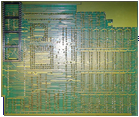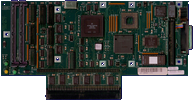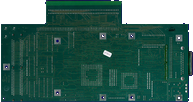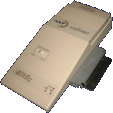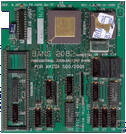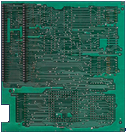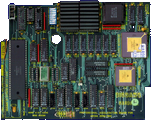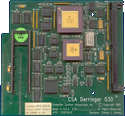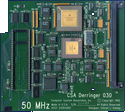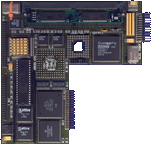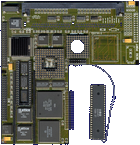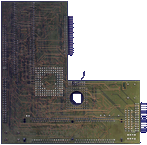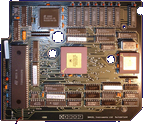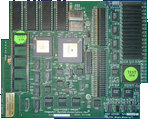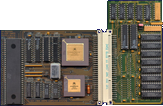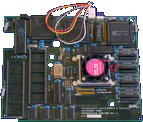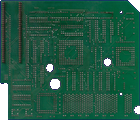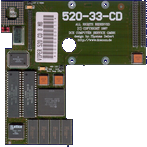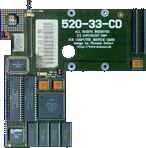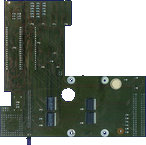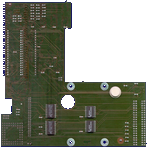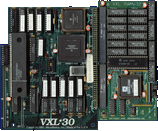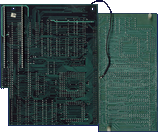Search Result
37 expansions found
Company Solid State Leisure, UK | Date 1992 | Amiga A500, A2000 | Interface 68000 socket |
- processor
- 68020 @ 16.67 MHz, PGA
- optional PGA FPU, no MMU
- memory
- 1 MB RAM installed, expandable to 4 MB
- 32 DIP sockets
- takes 256k×4, 80 ns or faster DIPs
- non-autoconfiguring
- hardware maprom
- does not support DMA to its 32 bit RAM, it affects the A590 badly - DMAfix can solve this
- notes
- connects to the 68000 socket, the 68000 is replaced onto the board
- 68000 fallback mode - the software can switch from 68030 to 68000 but cannot switch back, the machine has to be switched off
- HDToolBox gets confused with the board (it works correctly in fallback mode)
- memory is not available in fallback mode
Company Great Valley Products, USA | Date 1992 | Amiga A500 | Interface side expansion port | Autoconfig ID 2017 / 11 |
- processor
- 68EC030 @ 40 MHz PGA
- optional 68882 @ 40 MHz PGA
- memory
- two 64 pin SIMM sockets accept 1, 2, 4 or 8 MB RAM
- supports special 1 or 4 MB GVP SIMMs
- SIMM sizes cannot be mixed
- hardware maprom
- SCSI 2 DMA controller
- FaaaST ROM SCSI driver
- 3.58 MB/s maximum transfer speed
- 50 pin internal SCSI connector
- DB25F external SCSI connector
- hard disk activity LED
- place for a 3.5" hard disk inside the case
- supported by Linux and NetBSD
- notes
- mini expansion slot for the optional GVP PC286 AT emulator
- connects to the side expansion port
- no passthrough connector
- disable switch on top of the case
- in 68000 fallback mode both the RAM and hard disk are deactivated
- external power supply
- built in fan
- jumper settings
| J1 - | MMU: ON - disable |
| J2 - | 68000 fallback mode: OFF - enable |
| J3 - | CPU cache: ON - disable |
| J9 - | autoboot: OFF - disable |
| J11 - | RAM: ON - not installed, OFF - installed |
| J13 - | SIMM size: ON - 4 MB, OFF - 1 MB |
| J4, J6 ON | J5, J7, J8, J10, J12 OFF | CN7, CN18 1-2 | CN8, CN11 2-3 | - reserved |
- a530.dms
GVP-M
install disk
405 kB - amiga.html#gvp
Ralph Babel
SCSI ROM image
gvpscsi.device v4.15
16 kB
Company Individual Computers, Germany | Date 2013 | Amiga A500 | Interface side expansion port | Autoconfig ID 4626 / 64 |
- processor
- CPU: 68EC000 @ 14 MHz
- CPU is overclocked, the nominal speed of the CPU is 10 MHz
- memory
- 2 MB RAM
- memory autoconfiguration
- 512k Flash ROM, it contains a licensed Kickstart 1.3 and 3.1
- installed trapdoor expansions are supported
- 512k expansions can be added as either ChipRAM or FastRAM - an ECS Agnus is needed for ChipRAM option
- if larger than 512k, automatically added as FastRAM
- notes
- delivered without case, meant to be installed as-is (bare board)
- MapROM feature
- two CF card slots (replace hard disk)
- one slot supports autoboot from Amiga formatted CF cards with RDB
- no hotplug support
- one slot supports FAT16/FAT32 formatted CF cards to allow data exchange with PCs (no software needed, FAT95 filesystem in ROM)
- not all CF cards are working, try-and-error procedure may be necessary to find a working one
- boot menu with the following options
- select between Kickstart ROM installed in Amiga or one of the two Kickstarts in Flash ROM of ACA 500
- floppy options - allows deactivation or no-click mode
- switch between PAL and NTSC modes
- load A1000 Kickstart disk
- issue flash software update from CF card
- store and select configuration profiles and a standard configuration
- language selection (english or german)
- A1200 compatible clock port
- A1200 CPU port
- allows installing processor cards for A1200 CPU slot
- supported are only three models: ACA 1220, ACA 1232 and ACA 1233
- other cards may work, reported are Blizzard PPC, Blizzard 1260, Blizzard 1230 IV, Apollo 1260, Cobra
- the ACA 1231, being an OEM product, does not work
- 16 bit I/O expansion port
- de-brick jumper, disables certain RAM and ROM functions to allow flashing a new ROM
- compatibility jumper (J2)
- disables RAM and certain IRQs
- CF card slots, expansion and clock ports disabled
- MapROM disabled
- other features to increase compatibility
- compatible with WHDLoad game software (Quit key is also supported), however due to limited amount of RAM on the card many games do not work
Company ICD, USA | Date 1990 | Amiga A500, A1000, A2000 | Interface 68000 socket |
- 68000 @ 14.3 MHz
- 32 kB SRAM - 16 kB cache and 16 kB of cache tags - reduces the time required to read and write to Fast RAM
- connects to 68000's socket
- can be disabled at any time through software or an optional hardware switch
- AdSpeed.pdf
Owner's Manual (english)
78 kB
- AdSpeed.dms
AdSpeed program v1.0
9 kB - AdSpeed-20.dms
AdSpeed program v2.0
12 kB
Company ICD, USA | Date 1991 | Amiga A500 | Interface 68000 socket |
- 68000 @ 14.3 MHz
- 32 kB SRAM (16 kB cache and 16 kB cache tags)
- CPU speed can be changed via software (or an optional switch) even when running programs
- onboard IDE controller
- 40 pin IDE header
- incompatible with Western Digital and IBM hard disks
- connects to 68000's socket
- AdSpeed-20.dms
AdSpeed program v2.0
12 kB - AdSpeed.dms
AdSpeed program v1.0
9 kB - ICDPrepHD-42.dms
install disk v4.2
ICDPrepHD v4.2, adide.device v4.0r1, adscsi.device v4.0r1, icddisk.device v3.5r1, trifecta.device v4.0r1
117 kB - ICDPrepHD-40.dms
install disk v4.0
ICDPrepHD v4.0, adide.device v4.0r1, adscsi.device v4.0r1, icddisk.device v3.5r1, trifecta.device v4.0r1
117 kB
Company Harms Computertechnik, Germany | Date 1989 | Amiga A500, A2000 | Interface 68000 socket |
- processor
- 68020 @ 14 MHz PGA
- optional PGA FPU, clocked with a separate oscillator
- notes
- the board was delivered as a kit, the user had to solder the sockets for CPU & FPU, a resistor pack, 6 capacitors and the 68000 socket
- if no FPU is used, pin 18 of U4 has to be connected with pin 22 of the 68000 socket
- no option for memory expansion
- Turbo-Board I:
- no 68000 fallback mode
- Turbo-Board II:
- 68000 fallback mode selectable by switch
- the 68000 is factory installed on the board
Company ACT Elektronik, Germany | Date 1994 | Amiga A500 | Interface side expansion port |
- processor
- 68020 @ 25 MHz PGA
- 68881 @ 25 MHz - 68882 @ 50 MHz PGA
- memory
- eight ZIP sockets accept 1 or 4 MB RAM
- supports 256k×4 or 1M×4 Fast Page or Static Column ZIPs
- accepts ZIPs in a group of eight only
- selectable 0 or 1 wait states
- memory disable switch
- memory autoconfig on power on
- notes
- connects to the side expansion port or to the internal expansion connector of the Apollo 500 SCSI controller
- passthrough connector for other side peripherals
Company Evolution Computer Systems, Germany | Date 1992 | Amiga A500, A2000 | Interface 68000 socket |
- 68000 @ 14 MHz (overclocked 12 MHz unit)
- optional PGA FPU, 68881 @ 14 MHz (synchronous) or more with separate oscillator (asynchronous)
- connects to the 68000's socket
- Avanti.pdf
user manual (german)
434 kB
- Avanti.dms
tool disk, performance programs
MandelVroom v2.0
337 kB - Evolution-FPU.dms
FPU support disk, programming examples, libraries
52 kB
Company Solid State Leisure, UK | Date 1992 | Amiga A500, A2000 | Interface 68000 socket |
- processor
- 68030 @ 25 or 68EC030 @ 40 MHz, PGA
- optional 68882 @ 25 - 50 MHz, PGA
- memory
- 1 MB RAM installed, expandable to 4 MB
- 32 DIP sockets
- takes 256k×4, 80 ns or faster DIPs
- non-autoconfiguring
- hardware maprom
- notes
- does not support DMA to its 32 bit RAM - DMAfix solves this
- after a reboot, DMA into Zorro II memory larger than 512 bytes causes the machine to hang - DMAfix helps here too
- 68000 fallback mode - the software can switch from 68030 to 68000 but cannot switch back, the machine has to be switched off
- memory is not available in fallback mode
Company Hardital, Italy | Date 1990 | Amiga A500, A2000 | Interface 68000 socket |
- processor
- 68020 @ 14.3 MHz (synchronous), PGA
- optional FPU up to 68882 @ 25 MHz (asynchronous), PGA
- notes
- no memory expansion
- plugs into the 68000 socket, the 68000 is replaced onto the board
- jumper to select the CPU (labelled DEV1 on the board) - if shorted, the 68020 is used
- an optional accessory ("Remote Controller") connects to the jumper and allows selection of the CPU from the outside
Company Hardital, Italy | Date 1991 | Amiga A500 | Interface 68000 socket |
- processor
- 68030 @ 50 MHz, PGA
- optional PGA FPU, up to 68882 @ 50 MHz
- memory
- sixteen ZIP sockets accept up to 8 MB RAM
- accepts 1M×4 ZIPs in groups of four
- supports 2, 4 or 8 MB configurations
- the memory is mapped into the 16 bit address space - all Fast RAM expansions are ruled out
- DMA devices cannot use this memory - all DMA capable hard disk controllers are ruled out
- notes
- 68000 fallback switch
- in 68000 mode the memory remains available
- plugs into the 68000 socket, the 68000 is replaced onto the board
Company Phase 5 Digital Products, Germany | Date 1992 | Amiga A500, A2000 | Interface 68000 socket | Autoconfig ID 8512 / 1,2 |
- processor
- 68000 @ 14 MHz
- memory
- sixteen DIP sockets accept 1, 2, 3, 4, 5, 6 or 8 MB RAM
- supports 256k×4 or 1M×4, 100 ns DIPs
- accepts DIPs in groups of four
- DIP sizes can be mixed
- Shadow RAM
- optional 512 kB SRAM for Kickstart remapping
- four DIP sockets for 256k×4 chips
- notes
- connects to the 68000's socket
- software switchable 7 MHz fallback mode
Company Computer System Associates, USA | Date 1992 | Amiga A500, A2000 | Interface 68000 socket |
- processor
- 68030 @ 25 / 33 / 40 / 50 MHz, PGA
- optional PGA FPU, 68881 @ 25 MHz - 68882 @ 50 MHz
- memory
- one 72 pin SIMM socket accepts 32 MB 60 ns RAM
- supports 1, 2, 4, 8, 16, 32 MB SIMMs 60-80 ns
- hardware maprom
- notes
- connects to the 68000's 64 pin DSIP socket
- the 68000 is replaced onto the board
- the board is basically an updated version of the Mega-Midget Racer
- 68000 fallback mode selectable by hardware or software switch
- Derringer030.pdf
User's Manual (english)
33 kB
- Derringer.dms
install disk
360 kB - CSA_Derringer.DMS
Installer's Heaven
install disk
360 kB
Company Rex Datentechnik, Germany | Date 1992 | Amiga A500 | Interface side expansion port |
- five 86 pin A2000 style CPU slots
- allows processor cards made for the A2000 to be used in the A500
- only one DMA capable card can be used at a time
- A500 expansions can be plugged in the slots using adapters cards
- individual slot disable switches and activity LEDs
- DMA-Expander.pdf
Bedienungsanleitung
14 kB
Company M-Tec, Germany | Date 1997 | Amiga A500 | Interface 68000 socket | Autoconfig ID 2192 / 33,36 |
- processor
- 68030 @ 50 MHz PGA
- 68000 @ 7.14 MHz PLCC
- optional 68882 @ 50 MHz PGA
- memory
- one 72 pin SIMM socket accepts 128 MB RAM
- SCSI 2 and IDE
- two 40 pin IDE connectors for up to four devices
- one 44 pin 2.5" IDE hard disk connector
- NCR 53C94 SCSI controller
- one SCSI connector
- notes
- connects to 68000 socket
- Kickstart 2.05 ROM on board - the minimum for bootable IDE
- Gayle on board
Company Kupke, Germany | Date 1991 | Amiga A500 | Interface side expansion port | Autoconfig ID 2073 / 4 |
- processor
- 68030 @ 14 MHz, PGA (synchronous with the A500)
- optional PGA FPU - it can run at 14 MHz, or use a separate crystal
- memory
- 32 DIP sockets accept up to 16 MB RAM
- supports 256k×4 or 1M×4 chips
- accepts chips in groups of eight
- possible memory configurations are 1, 2, 3, 4, 5, 6, 7, 8, 9, 10, 12, 13 or 16 MB
- notes
- connects to the side expansion port
- passthrough connector for other side peripherals
- conflicts with the A590 SCSI controller
- disable switch on top of the case
- jumper settings
| Jumper | Default | Description |
| JP101 | - | FPU Oscillator: 1-2 - no oscillator present, 2-3 - oscillator present |
| JP201 | OFF | MMU Disable: ON - MMU disabled, OFF - MMU enabled |
| JP202 | OFF | CPU Cache Disable: ON - Cache disabled, OFF - Cache enabled |
| JP302 | ON | Cache Chip Memory: ON - caching disabled, OFF - caching enabled |
| JP303 | - | 1MBit/4MBit: ON - 1MBit, OFF - 4 MBit |
| JP304 | - | reserved |
| JP305 | - | reserved |
Company Omega Datentechnik, Germany | Date 1992 | Amiga A500, A2000 | Interface 68000 socket |
- 68020 @ 14 - 25 MHz, PGA
- 68881 @ 14 - 25 MHz, PGA
- 128 kB static RAM cache, expandable to 512 kB
- connects to 68000 socket
Company Daniel Instruments / IMtronics, Switzerland | Date 1988 | Amiga A500, A2000 | Interface 68000 socket |
- processor
- 68020 @ 14.3 MHz, PGA (synchronous with the A500)
- optional 68881 or 68882 up to 33 MHz, PGA (asynchronous)
- memory
- eight DIP sockets for 1 or 4 MB 32 bit RAM
- accepts 256k×4 or 1M×4 DIPs
- no waitstates with 70 ns RAM
- although the memory is mapped inside the 68000 memory space, it is not DMA-able
- notes
- connects to the 68000's socket, the 68000 is replaced onto the board
- 68000 fallback mode
Company M-Tec / Neuroth Hardware Design, Germany | Date 1992 | Amiga A500, A2000 | Interface 68000 socket |
- processor
- 68020 @ 16 MHz PGA, clocked at 14.3 MHz (synchronous)
- optional PLCC FPU, either clocked at 14.3 MHz or more by installing an oscillator
- memory
- the board exists in two different layouts, one with either 1 or 4 MB RAM, the other without RAM at all
- the RAM autoconfigures itself to the same Address space as the RAM on the A590, A2091 or GVP Series II
- notes
- plugs into 68000 socket, the 68000 is replaced onto the board
- 68000 fallback jumper
- cache disable jumper
- compatible with both the A2000-A and A2000-B
Company M-Tec, Germany | Date 1994 | Amiga A500 | Interface 68000 socket | Autoconfig ID 2192 / 6 |
- processor
- 68020 or 68EC020 @ 14.28 MHz, PGA (synchronous with the Amiga)
- optional PLCC or PGA FPU @ 14.28 MHz (synchronous) or more with oscillator (asynchronous)
- memory
- one 72 pin SIMM socket accepts 1 or 4 MB RAM
- maprom can be disabled by jumper
- notes
- connects to the 68000's socket
- the 68000 is replaced onto the board
- not compatible with the GVP Impact Series hard disk controller
Company M-Tec / Neuroth Hardware Design, Germany | Date 1993 | Amiga A500, A2000 | Interface 68000 socket | Autoconfig ID 2192 / 3 |
- processor
- 68030 @ 14 MHz PGA (synchronous with the motherboard)
- optional PLCC FPU up to 40 MHz (asynchronous)
- memory
- 1 or 4 MB RAM soldered to the board
- does not autoconfig, the memory has to be added to the system by software
- the RAM appears in the 16 MB 68000 address space, so the board may conflict with other expansions
- notes
- plugs into 68000 socket, the 68000 is replaced onto the board
- 68000 fallback jumper
- MMU disable jumper
- cache disable jumper
- MTec-Turbotools-220.dms
Turbo Tools v2.20
193 kB - mtec.a500.030.DMS
Installer's Heaven
install disk
192 kB
Company Computer System Associates, USA | Date 1990 | Amiga A500, A1000, A2000 | Interface 68000 socket |
- processor
- 68EC030 @ 25 / 33 MHz or 68030 @ 16 / 20 / 25 / 33 / 38 MHz, PGA
- optional 68882 PGA FPU, up to 50 MHz
- memory
- optional 512 kB SRAM
- much faster (and more expensive) than DRAM
- four sockets for 128 kB SRAMs
- can be used for Kickstart remapping
- optional DIP DRAM expansion module (Mega-Memory 2130)
- 16 DIP sockets accept 0.5 - 8 MB RAM
- supports 256k×4 and 1M×4 DIPs, 60 - 100 ns
- if installed in an A2000 the board overhangs the video slot
- optional ZIP DRAM expansion module (Mega-Memory 2150)
- 16 ZIPs soldered on board
- uses 256k×4 or 1M×4 ZIPs, 60 - 100 ns
- does not protrude over the video slot
- the memory does not autoconfig, it needs software
- does not support DMA to its 32 bit memory
- notes
- connects to the 68000 socket, the 68000 is replaced onto the board
- 68000 fallback mode
Company C't, Germany | Date 1987 | Amiga A500 | Interface 68000 socket |
- Prozessor Austausch Karte - Processor Exchange Board
- developed by the editors of the german computer magazine c't
- schematics has been fully published in the magazine
- designed to emulate the MC68000 processor bus interface at best, so it can be used in Ataris and Macs as well
- processor
- 68020 @ 12 / 16 MHz, PGA (asynchronous to the motherboard)
- optional 68881 @ 12 / 16 MHz, PGA - runs at the same speed as the CPU
- memory
- optional daughter board with four 32k×8 ROM or SRAM chips
- two boards can be stacked on each other for 256 kB ROM / SRAM total
- notes
- plugs into the 68000's socket
- no 68000 fallback mode
Company C't, Germany | Date 1991 | Amiga A500 | Interface 68000 socket |
- successor of the original PAK-68 (Prozessor Austausch Karte - Processor Exchange Board)
- developed by the editors of the german computer magazine c't
- schematics has been fully published in the magazine
- can be used in 68000 based Ataris and Macs as well
- less error prone design - processing flow with state machines
- the discrete logic had been put into GALs, allowing easy reconfiguration in case of timing changes
- the GAL based layout is smaller, making room for ROM/RAM sockets which were located on piggy-back boards on the old board
- processor
- 68020 @ 14 / 16 MHz, PGA
- optional 68881 or 68882 @ 14 / 16 MHz, PGA - runs at the same speed as the CPU
- memory
- four 32 pin sockets for up to 512 kB ROM / SRAM
- when occupied with ROMs, access to OS ROM is 32 bit wide
- SRAMs with 100ns or faster access speed can also be fitted but an additional decoder GAL is necessary
- ROM access can be sped up by 40% by setting a jumper, which disables ROM synchronisation to the 8 MHz clock
- notes
- plugs into the 68000's socket
- either a 68000 has to be put on top of the board or an additional GAL has to be installed
Company C't, Germany | Date 1994 | Amiga A500 | Interface 68000 socket |
- third generation of the Prozessor Austausch Karte - Processor Exchange Board
- developed by the editors of the german computer magazine c't
- schematics and GAL equations has been fully published in the magazine
- designed to emulate the MC68000 processor bus interface at best, so it can be used in Ataris and Macs as well
- processor
- PAK-68/3-020: 68020
- PAK-68/3-030: 68030
- 14.3 MHz (synchronous) or 32 / 36 / 40 MHz (asynchronous) - could be run in either modes, but requires different GALs
- optional 68881 or 68882 - runs at the same speed as the CPU
- memory
- optional 32 kB level 2 cache
- four EPROM sockets for 32 bit Kickstart access
- memory expansion is possible for the 030 version only
- notes
- the 020 and 030 versions have slightly different layout
- five GALs - there are different GAL sets for each configuration (computer type, CPU type, CPU mode)
- plugs into the 68000's socket
- optional 68000 fallback mode - the 68000 can be installed onto the PAK with an additional GAL
Company Creative Microsystems, USA | Date 1988 | Amiga A500 | Interface 68000 socket |
- processor
- 68000 @ 14.32 MHz, synchronous to the motherboard
- software and jumper switchable 7 or 14 MHz mode
- optional PGA FPU up to 16 MHz with separate oscillator
- notes
- jumper selectable Fast ROM mode for accessing the Kickstart ROM with reduced wait states
- some DMA devices (for example the A590) do not work when the board runs at 14 MHz, unless the PAMC board is modified (trace cut)
- plugs into the 68000's socket
- electrically the same as the A2000 version, it only differs in its shape to allow the installation of Agnus expansions (like the MegAChip)
- CMI_PA-90.dms
utility disk
PA program v9.0
195 kB
Company Harms Computertechnik, Germany | Date 1990 / 1989 | Amiga A500 | Interface 68000 socket |
- processor
- 68020 @ 14.3 MHz - 68030 @ 28.5 MHz, PGA
- optional PGA FPU
- optional memory board
- eight DIP sockets accept 1 or 4 MB RAM
- supports 256k×4 and 1M×4 DIPs
- mixing of different DIP sizes is not possible
- does not autoconfig
- although the memory is mapped inside the 68000 memory space, it is not DMA-able
- notes
- connects to 68000 socket - the 68000 is replaced onto the board
- 68000 fallback mode
Company Harms Computertechnik, Germany | Date 1993 | Amiga A500 | Interface 68000 socket | Autoconfig ID 2560 / 16 |
- processor
- 68030 @ 28.5 MHz, PGA
- optional PLCC FPU up to 68882 @ 60 MHz
- memory
- sixteen ZIP sockets accept 1, 2, 4, 8 MB RAM
- supports 256k×4 and 1M×4 ZIPs
- mixing of different ZIP sizes is not possible
- no memory autoconfig
- notes
- connects to 68000 socket - the 68000 is replaced onto the board
- 68000 fallback mode
- jumper settings
| JP1 | - CPU: ON - 68000 and no RAM, OFF - 68030 |
| JP5 | - cache: ON - disabled |
| JP6 | - MMU: ON - disabled |
| JP2 OFF OFF OFF OFF ON ON ON ON |
JP3 OFF OFF ON ON OFF OFF ON ON |
JP4 OFF ON OFF ON OFF ON OFF ON |
- RAM - 1 MB, slots 1-8, address 090000-09ffff - 1 MB, 1-8, 4070000-09ffff - 2 MB, 1-16, 080000-09ffff - 2 MB, 1-16, 4060000-407ffff - 4 MB, 1-8, 060000-09ffff - 4 MB, 1-8, 4040000-407ffff - 8 MB, 1-16, 020000-09ffff - 8 MB, 1-16, 4000000-407ffff |
- Professional030plus500.pdf
Benutzerhandbuch
890 kB
- Professional030Plus_A500.dms
install disk for OS1.3 / OS2.0
146 kB
Company Progressive Peripherals & Software, USA | Date 1992 | Amiga A500 | Interface 68000 socket | Autoconfig ID 2026 / 187 |
- processor
- 68040 @ 28 / 35 MHz
- both version is an overclocked 25 / 33 MHz one
- memory
- sixteen ZIP sockets accept 4 or 8 MB RAM
- supports 1M×4 ZIPs
- autoconfigures all A500 internal / external RAM
- notes
- connects to the 68000 socket - the 68000 is replaced onto the board
- RF shield must be removed - the 040 is too big to fit under it
- Kickstart 2.04 ROM built in - the 040 does not work under 1.3
- 68000 fallback mode switchable by software
Company TTR Development, USA | Date 1990 | Amiga A500, A1000, A2000 | Interface 68000 socket |
- processor
- 68020 @ 7.14 MHz PGA
- 68882 @ 7.14 MHz PGA
- both the CPU and FPU are capable of 12 MHz, but they run at the internal clock speed of the A500
- notes
- connects to 68000 socket
- no 68000 fallback mode
- no memory option
- very small board, just 3 1/8" x 4 1/4" x 1/2"
Company Daniel Instruments / IMtronics, Switzerland | Date 1990 | Amiga A500, A2000 | Interface 68000 socket | Autoconfig ID 256 / 0 |
- processor
- 68030 @ 16 / 22 / 28 / 36 / 50 MHz, PGA
- 68882 @ 16 / 22 / 28 / 36 / 50 / 60 MHz, PGA
- memory
- sixteen ZIP sockets accept 1, 2, 4 or 8 MB RAM
- supports 256k×4 and 1M×4 ZIPs, 60-100 ns, in groups of eight
- ZIP types cannot be mixed
- the 50 MHz version requires at least 70 ns ZIPs
- autoconfig disable jumper
- no autoconfig: RAM is added with software out of the Zorro II 8 MB address space
- autoconfig: RAM is mounted in the 8 MB address space so it may interfere with other RAM expansions
- notes
- connects to the 68000's socket, the 68000 is replaced onto the board
- 68000 fallback mode - the memory expansion remains available
- connector for additional power from the floppy power cable
- jumper settings
- J3: left = Memory activated / right = Memory deactivated
- Boss: ON = 68030 / OFF = 68000 fallback mode
Company Supra, USA | Date 1993 | Amiga A500A2000 | - - | Interface side expansion portCPU slot |
- 68HC000 @ 28 MHz
- 16 kB static RAM cache
- without the cache, the processor would only access the Amiga's memory at 7 MHz
- only programs loaded into Fast RAM are available for caching
- disable switch
- can be slowed down by software to 7.14 MHz without rebooting
- A500 version:
- connects to the side expansion port
- passthrough connector
- A2000 version:
- connects to the CPU slot
- not compatible with the Commodore BridgeBoards
Company Roßmöller, Germany | Date 1990 | Amiga A500, A2000 | Interface 68000 socket |
- 68000 @ 14 MHz
- optional 68881 @ 14 MHz or more with separate oscillator
- 16 kB Cache RAM
- connects to the 68000's socket
Vapourware
Company BSC, Germany | Date 1991 | Amiga A500, A2000, A3000 |
- processor expansion (never released)
- 68030 or 68040, 25 - 50 MHz
- optional FPU
- SCSI-II controller
Company Masoboshi / DCE, Germany | Date 1997 | Amiga A500 | Interface 68000 socket | Autoconfig ID 2157 / 0 |
- processor
- 68EC020 @ 33 MHz QFP
- optional 68882 @ 33 MHz PGA
- memory
- 4 or 8 MB RAM on board
- not expandable
- IDE controller
- two 40 pin IDE connectors
- 44 pin connector and space for a 2.5" hard disk on the board
- notes
- connects to 68000 socket
- Kickstart 3.0 ROM on board, 130 ns access
- Viper520.pdf
DCE
user manual (german)
413 kB
Company Power Computing, UK | Date 1997 | Amiga A500 | Interface 68000 socket | Autoconfig ID 2192 / 33,36 |
- the Viper 530 is a name variation of the E-Matrix 530 as used by Power Computing
Company Microbotics, USA | Date 1991 | Amiga A500, A2000 | Interface 68000 socket | Autoconfig ID 1010 / 68,691010 / 136 |
- processor
- 68EC030 or 68030 @ 25 / 40 / 50 MHz
- optional PLCC FPU up to 68882 @ 50 MHz
- optional VXL RAM-32 memory board
- the VXL RAM-32 board needs a VXL-030 rev3.0 board, older revisions (v1.0 and v2.0) must be upgraded (exchange of 10 ICs)
- 2 or 8 MB RAM using sixteen 256k×4 or 1M×4 DIP chips
- Kickstart socket for a 2.04 ROM - not accessed in 68000 mode
- hardware maprom even from the motherboard ROM
- burst RAM access selectable with a jumper - works only with 60 ns page mode DIPs
- RAM access speed selectable with a jumper, 60 or 80 ns
- the address space of the memory can be set inside or outside of the 68000 memory space
- if set inside, DMA is supported into the 32 bit RAM
- in 68000 mode the RAM is still usable, it just becomes 16 bit wide
- notes
- the 68000 fallback mode is switchable either by software or jumper
- connects into the 68000 socket - the 68000 is replaced onto the board
- VXL30-Installation.pdf
Installation and Operations Guide to VXL*30 and RAM-32 (english)
54 kB - VXL30-Configuration.pdf
Configuration, Chip Installation, and Upgrade Notes (english)
432 kB - VXL30-Upgrade.pdf
Upgrade Notes for Use with RAM-32 (english)
168 kB - VXL30-RAM32.pdf
RAM32 - Installation and Configuration Diagram and Notes (english)
236 kB - VXL30-Sticker1.png
sticker (english)
77 kB
- VXL30-12.dms
setup disk v1.2
239 kB
 Amiga Hardware Database
Amiga Hardware Database
